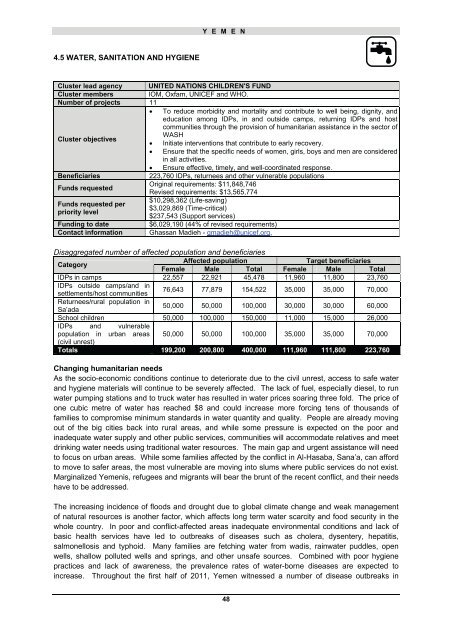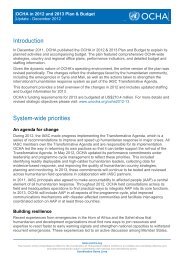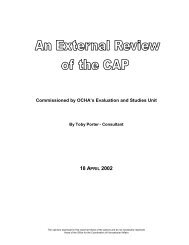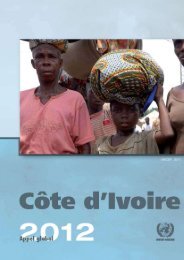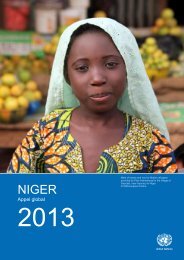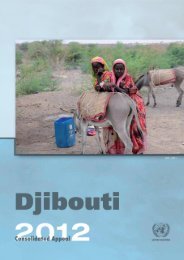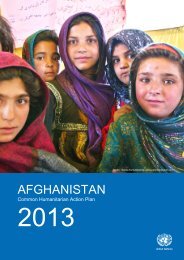Yemen 2011 Mid-Year Review - UN OCHA Webmail
Yemen 2011 Mid-Year Review - UN OCHA Webmail
Yemen 2011 Mid-Year Review - UN OCHA Webmail
- No tags were found...
You also want an ePaper? Increase the reach of your titles
YUMPU automatically turns print PDFs into web optimized ePapers that Google loves.
Y E M E N4.5 WATER, SANITATION AND HYGIENECluster lead agency <strong>UN</strong>ITED NATIONS CHILDREN'S F<strong>UN</strong>DCluster membersIOM, Oxfam, <strong>UN</strong>ICEF and WHO.Number of projects 11• To reduce morbidity and mortality and contribute to well being, dignity, andeducation among IDPs, in and outside camps, returning IDPs and hostcommunities through the provision of humanitarian assistance in the sector ofWASHCluster objectives• Initiate interventions that contribute to early recovery.• Ensure that the specific needs of women, girls, boys and men are consideredin all activities.• Ensure effective, timely, and well-coordinated response.Beneficiaries223,760 IDPs, returnees and other vulnerable populationsOriginal requirements: $11,848,746Funds requestedRevised requirements: $13,565,774$10,298,362 (Life-saving)Funds requested per$3,029,869 (Time-critical)priority level$237,543 (Support services)Funding to date$6,029,190 (44% of revised requirements)Contact information Ghassan Madieh - gmadieh@unicef.org,Disaggregated number of affected population and beneficiariesCategoryAffected populationTarget beneficiariesFemale Male Total Female Male TotalIDPs in camps 22,557 22,921 45,478 11,960 11,800 23,760IDPs outside camps/and insettlements/host communities76,643 77,879 154,522 35,000 35,000 70,000Returnees/rural population inSa’ada50,000 50,000 100,000 30,000 30,000 60,000School children 50,000 100,000 150,000 11,000 15,000 26,000IDPs and vulnerablepopulation in urban areas 50,000 50,000 100,000 35,000 35,000 70,000(civil unrest)Totals 199,200 200,800 400,000 111,960 111,800 223,760Changing humanitarian needsAs the socio-economic conditions continue to deteriorate due to the civil unrest, access to safe waterand hygiene materials will continue to be severely affected. The lack of fuel, especially diesel, to runwater pumping stations and to truck water has resulted in water prices soaring three fold. The price ofone cubic metre of water has reached $8 and could increase more forcing tens of thousands offamilies to compromise minimum standards in water quantity and quality. People are already movingout of the big cities back into rural areas, and while some pressure is expected on the poor andinadequate water supply and other public services, communities will accommodate relatives and meetdrinking water needs using traditional water resources. The main gap and urgent assistance will needto focus on urban areas. While some families affected by the conflict in Al-Hasaba, Sana’a, can affordto move to safer areas, the most vulnerable are moving into slums where public services do not exist.Marginalized <strong>Yemen</strong>is, refugees and migrants will bear the brunt of the recent conflict, and their needshave to be addressed.The increasing incidence of floods and drought due to global climate change and weak managementof natural resources is another factor, which affects long term water scarcity and food security in thewhole country. In poor and conflict-affected areas inadequate environmental conditions and lack ofbasic health services have led to outbreaks of diseases such as cholera, dysentery, hepatitis,salmonellosis and typhoid. Many families are fetching water from wadis, rainwater puddles, openwells, shallow polluted wells and springs, and other unsafe sources. Combined with poor hygienepractices and lack of awareness, the prevalence rates of water-borne diseases are expected toincrease. Throughout the first half of <strong>2011</strong>, <strong>Yemen</strong> witnessed a number of disease outbreaks in48


